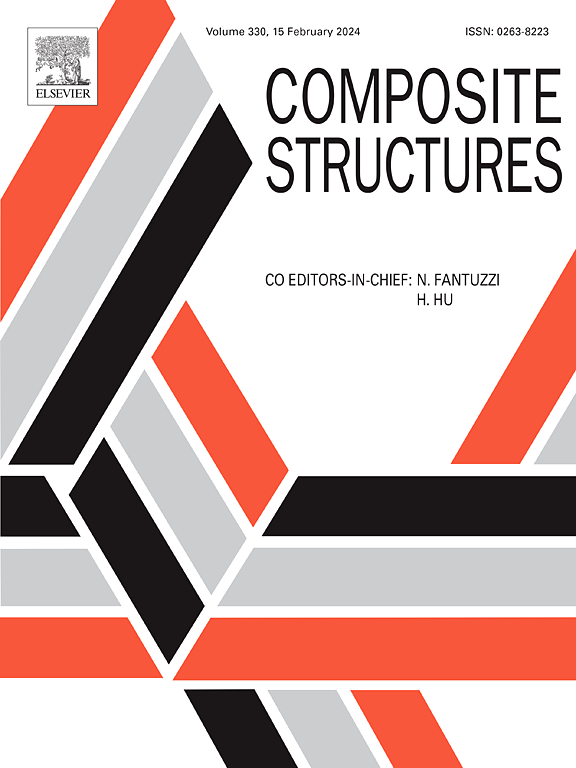Reinforcing shell elements for fiber-reinforced composites undergoing large deformations and general motion
IF 6.3
2区 材料科学
Q1 MATERIALS SCIENCE, COMPOSITES
引用次数: 0
Abstract
Fiber-reinforced composites offer excellent mechanical properties and lightweight advantages in multibody systems. However, their significant anisotropy and geometrical and material nonlinearities present challenges for accurate modeling and simulation. In this paper, two new types of reinforcing shell elements are developed within the Absolute Nodal Coordinate Formulation framework. The first type assumes that each fiber behaves as an Euler beam with only tensile and bending stiffness, making it suitable for simulating reinforcing fibers with arbitrary orientations and nonuniform materials and cross-section areas. The second type employs elastic force formulation based on Kirchhoff–Love theory or continuum mechanics. It is suitable for simulating reinforcing fibers that appear in a layered form with unique orientation, material, and cross-section area. The fibers and matrix are described independently in these new reinforcing elements, coupled through consistent deformation compatibility conditions. This approach allows different material models and element formulations for the fibers and matrix to be used. Furthermore, multiple fibers (or layers) can be embedded within a single reinforcing shell element, providing more accurate representations of the actual physical structure. The effectiveness of the developed reinforcing elements is validated through several benchmark problems. Numerical results demonstrate that both types of reinforcing shell elements are locking-free and can automatically capture the reinforcing effects of the fibers and the coupled deformation modes. This investigation enriches the element library of the Absolute Nodal Coordinate Formulation and provides an effective tool for the accurate simulation and optimal design of fiber-reinforced composites in multibody systems.

用于承受大变形和大运动的纤维增强复合材料的加固壳体元件
纤维增强复合材料在多体系统中具有优异的机械性能和轻量化优势。然而,它们显著的各向异性、几何非线性和材料非线性给精确建模和模拟带来了挑战。本文在绝对节点坐标法框架下,提出了两种新型的加筋壳单元。第一类假设每根纤维都表现为欧拉梁,仅具有拉伸和弯曲刚度,因此适用于模拟具有任意方向和非均匀材料和截面面积的增强纤维。第二类采用基于Kirchhoff-Love理论或连续介质力学的弹性力公式。适用于模拟具有独特取向、材料和横截面面积的分层形式出现的增强纤维。纤维和基体在这些新的增强元件中是独立描述的,通过一致的变形相容性条件耦合。这种方法允许使用不同的材料模型和纤维和基体的元素配方。此外,多个纤维(或层)可以嵌入在一个单一的增强壳单元中,提供更准确的实际物理结构表示。通过几个基准问题验证了所开发的加固单元的有效性。数值结果表明,两种类型的增强壳单元都是无锁紧的,可以自动捕捉纤维的增强作用和耦合变形模式。该研究丰富了绝对节点坐标公式的元素库,为纤维增强复合材料多体系统的精确仿真和优化设计提供了有效的工具。
本文章由计算机程序翻译,如有差异,请以英文原文为准。
求助全文
约1分钟内获得全文
求助全文
来源期刊

Composite Structures
工程技术-材料科学:复合
CiteScore
12.00
自引率
12.70%
发文量
1246
审稿时长
78 days
期刊介绍:
The past few decades have seen outstanding advances in the use of composite materials in structural applications. There can be little doubt that, within engineering circles, composites have revolutionised traditional design concepts and made possible an unparalleled range of new and exciting possibilities as viable materials for construction. Composite Structures, an International Journal, disseminates knowledge between users, manufacturers, designers and researchers involved in structures or structural components manufactured using composite materials.
The journal publishes papers which contribute to knowledge in the use of composite materials in engineering structures. Papers deal with design, research and development studies, experimental investigations, theoretical analysis and fabrication techniques relevant to the application of composites in load-bearing components for assemblies, ranging from individual components such as plates and shells to complete composite structures.
 求助内容:
求助内容: 应助结果提醒方式:
应助结果提醒方式:


